No CrossRef data available.

page 811 note 1 What we need just now for the Aśōka records is an index verborum which shall include the revised readings and additional materials obtained since the time when M. Senart's index was made. It should present the Sanskṛit equivalents, so as to expedite utilization of it.
page 815 note 1 The additional matter in the Mysore texts, introduced by the words se hēvaṁ Dēvānaṁpiye āha. (Brahmagiri, line 8–9), may be regarded, not as a separate edict, but as a supplement to the northern version: compare the frequent repetition of the words Dēvānaṁpiye Piyadasi lājā hēvaṁ āhā in the seventh pillar-edict.
page 815 note 2 We can, however, mostly quote only the Sahasrām, Rūpnāth, Brahmagiri, and Siddāpura texts. The Bairāt text is much damaged. And the JaṬiṅga-Rāmēśvara text is very fragmentary.
Mr Smith, in a footnote to the joint article (loc. cit., p. 23, note 6), has advised future editors of the Mysore texts to take note of “the very clear facsimiles” published by MrRice, in the Epigraphia Carnatica, vol. 11,Google Scholar Chitaldroog (“Bangalore” is a mistake), texts pp. 162, 164, 167. Practised epigraphists, however, will prefer to rely on the less clear but entirely mechanical reproductions given with Professor Biihler's article in the Epigraphia Indica, 3. 138 ff.Google Scholar
page 817 note 1 The different views are presented here in the order in which they were propounded.
page 817 note 2 He has referred to Nos. 1, 2, 5, and 6: No. 8 had not been published when he wrote. His view conies as No. 9: and the proposals in this matter now promise to become as numerous as those regarding the date of Kanishka.
page 818 note 1 This is the rendering of viyaṁjanēna here, against the proposed translation of viyaṁjanato in the third rock-edict by ‘with regard to the actual documents or figures, with regard to the accounts.’
page 819 note 1 He has had recourse to the expedient of assuming mistakes: we are to understand that the Sahasrām text has, not saḍ-vachhale, but sabiṁchhale for probably saṁvichhale (but ? saṁvichhale); and we are to regard the chha-vachhare of the Rūpnāth text as standing for savachhare, under the influence of the neighbouring chha's. But it is a primary rule that we are not to assume mistakes: we must apply ourselves to interpreting texts as they stand. And I may observe that I have already pointed out (see this Journal, 1907. 521, and note 2) that there are no grounds for the assumption, which has been made, of mistakes in another important word in the Rūpnāth text, lākhāpetavaya.
As a matter of fact, whether the second period was of six years or of one year is not of vital importance: the chronology of Aśōka's career can be arranged from either point of view. In agreement with Professor Bühler, however, I find in the Sahasrām and Rūpnāth texts the mention of a period of six years. In the Brahmagiri and Śiddāpura texts I find, with him, a mention of the same period, but—(and in this detail I differ from him)—with a special signalization of one year, the last of the six.